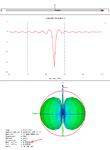AndreyG
Full Member level 4
- Joined
- May 10, 2010
- Messages
- 196
- Helped
- 27
- Reputation
- 54
- Reaction score
- 27
- Trophy points
- 1,308
- Location
- Vancouver, Canada
- Activity points
- 2,946
I modeled a structure in MWS - parallel plate transmission line shorted from both ends.
I contemplated using it as a radiator.
I can match such structure to 50 Ohm but model shows low Radiating Efficiency.
How can this be if I use Perfect Electrical Conductor in Free Space?
(I used to think that Radiating Efficiency less then 1 is result of energy loss due to finite conductivity of radiator and losses in dielectrics. My model have none. Where the energy goes?)
I contemplated using it as a radiator.
I can match such structure to 50 Ohm but model shows low Radiating Efficiency.
How can this be if I use Perfect Electrical Conductor in Free Space?
(I used to think that Radiating Efficiency less then 1 is result of energy loss due to finite conductivity of radiator and losses in dielectrics. My model have none. Where the energy goes?)
Last edited:
